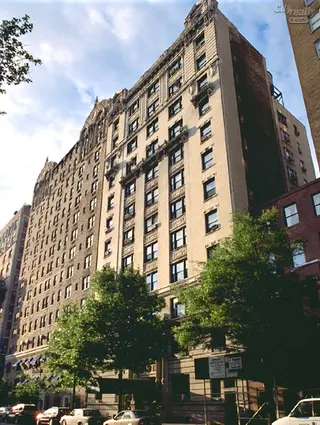 Carter Horsley
Carter HorsleyJan 27, 2014
Carter's Review
This very handsome, 12-story, pre-war, mid-block apartment building at 35 West 81st Street across from the American Museum of Natural History in Manhattan Square was erected in 1914.
The ornate and very handsome, white-brick building was designed by Neville & Bagge,
It has 68 co-operative apartments and is known as the Orvista after its developer Charles E. Orvis, a banker.
Bottom Line
A distinguished, mid-block pre-war apartment building across 81st Street from the American Museum of Natural History that was famed for its “Peaches” and “Daddy” penthouse.
Description
This very attractive building has a two-story rusticated base and bandcourses above the second and tenth floors. It has balconies in the center of its façade on the 9th floor and also at the corners of its 10th floor.
There are pilasters and corner rustication between the 11th and 12th floors and a bracketed cornice with large corner pediments.
The building has a two-step-up canopied entrance that leads to a white marble vestibule and lobby.
The building, which has sidewalk landscaping, has an exposed rooftop watertank and some protruding air-conditioners.
Amenities
The building has a gym.
Apartments
Most apartments have 10-foot-high ceilings and those on the first floor have 12-and-a-half-foot ceilings.
Apartment 11A is a two-bedroom unit with a large entry foyer that leads to a 18-foot-long living room with a 15-foot-long open kitchen with an island.
Apartment 8E is a one-bedroom unit with a 7-foot-long entry foyer that leads to an 18-foot-long living room and an 8-foot-long windowed kitchen.
Apartment 4D is a one-bedroom unit with a 9-foot-long entry foyer that has a 19-foot-long living room and a windowed, eat-in, 12-foot-long kitchen.
Apartment 2C is a studio with an 8-foot-wide entry foyer that leads to a 17-foot-long living room with an open kitchen.
History
According to a February 13, 2000 “Streetscapes” column in The New York Times by Christopher Gray, “around 1917, the developer Edward W. Browning took over the top floor and roof of the Orvista; he custom-built a grand apartment with fountains in the dining room and decorated in a stew of Gothic, French, Japanese, Elizabethan and other styles.”
Mr. Browning, Mr. Gray continued, “built an elaborate garden on the roof – including a pond big enough for a rowboat, and an early bug zapper that worked with electric lights, a powerful fan and a glass funnel.”
“The childless Browning was nicknamed ‘Daddy,’ and advertised to adopt young girls from poor families – attracting floods of applicants of mixed motives, applicants often older than they claimed. It appears he had left the Orvista by 1926 when, at age 51, he married 15-year-old Frances (Peaches) Browning. Their relationship last 10 months,” Mr. Gray wrote, added that his roof garden and apartment was later subdivided.
A March 15, 1998 “Streetscapes” column by Mr. Gray discussed Mr. Browning’s real estate interests and noted that he built a 25-story office building known as the World Tower building at 110 West 40th Street. It was designed by Buchman & Fox a firm that also designed for him three identical apartment buildings at 42 West 72nd Street, 118 West 72nd Street and 126 West 73rd Street, each 13 stories high and with Browning’s initials, “EWB,” in cartouches at the third floor.”
“In 1915, the 41-year-old Browning was married for the first time, to Nellie Adele Lowen. They moved to a rooftop apartment at 25 West 81st Street where Browning built an expansive garden. After moving, he announced plan to build a hangar atop the World Tower building, saying he would commute there by airplane. He also promised he would drop leaflets and dummy bombs on Times Square, because he felt New Yorkers were insufficiently concerned about the perils of aerial bombing.
In his great book, “Upper West Side Story,” Peter Salwen notes that about 12,000 young women responded to Mr. Browning’s advertisement for a young woman to be a companion for his daughter and that all “were dandled on his knee and interviewed, but nothing much came of it.”
“To console himself,” Mr. Salwen continued, “Browning became a ‘patron’ of high-school sorority dances, and then he achieved his heart’s desire: he married Frances Belle Heenan, a plump, pouty fifteen-year old from Washington Heights. He called her ‘Peaches,’ she called him ‘Daddy,’ and for reasons hard to fathom at this distance, the public couldn’t get enough of them. An inspired journalist had labeled it The Era of Wonderful Nonsense, and Daddy and Peaches were true tabloid fair, right in there with flagpole sitters, goldfish swallowers, and nine-day bicycle racers.”

- Co-op built in 1914
- Converted in 1986
- Located in Central Park West
- 68 total apartments 68 total apartments
- 10 recent sales ($305K to $3.3M)
- Doorman





 6sqft delivers the latest on real estate, architecture, and design, straight from New York City.
6sqft delivers the latest on real estate, architecture, and design, straight from New York City.
